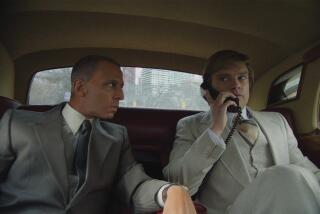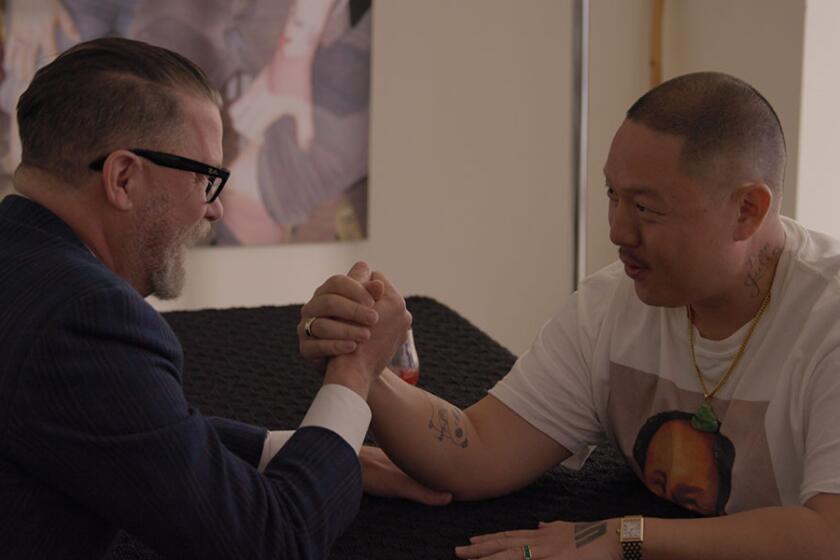From the Archives: Roger Corman: Hollywood’s original low-budget superhero
In “Corman’s World: Exploits of a Hollywood Rebel,” a documentary opening Friday about indie film godfather Roger Corman, there’s a scene that neatly illustrates his filmmaking philosophy. During the making of the 2010 film “Dinoshark,” a crew member is standing knee-deep in the ocean, holding an obviously fake giant crocodile, which he is preparing to have bite the neck of a beautiful girl in a bikini.
Nearby, Corman, wearing a polo shirt and yacht cap, coolly explains the narrative thrust of the film. “We feel the monster should kill somebody, fairly early, and then at regular intervals through the picture. The first kill should be fairly shocking and then less so ... until the climax, when there is blood all over the screen.”
Over the course of an amazing half-century career in filmmaking, Corman, now 85, has produced or directed hundreds of low-budget scarefests, teen adventures and sci-fi fantasies. He’s known for an uncanny ability to jump on a trend immediately. In fact, he’s basically the polar opposite of today’s mainstream moviemaking, where the lumbering studio development process takes years, budgets run into the hundreds of millions of dollars, and only the most spectacular, super-realistic special effects will do.
Given today’s extremely uncertain economic times, and Hollywood’s aversion to risk, I’d argue that Corman’s approach deserves a second look. And if studios won’t learn from it, maybe a new generation of independent filmmakers — who, thanks to leaps in technology, have much more sophisticated equipment than Corman ever did — can and will.
You could recruit an impressive all-star team from the actors and filmmakers who apprenticed with Corman, notably Jack Nicholson, James Cameron, Martin Scorsese, Robert De Niro, Jonathan Demme, Ron Howard, Peter Bogdanovich, John Sayles, Paul W.S. Anderson, Allan Arkush and Joe Dante. Most of them are in the documentary, telling lively tall tales about how much they were able to accomplish with so little and, in the case of Nicholson, actually weeping as he recalled the opportunities Corman gave him early on.
When I visited Corman the other day at his modest Brentwood offices, he was just as Scorsese describes him in the film: eloquent, elegant and precise. Having made most of his movies for less than the catering budget of today’s mega-blockbusters, Corman was especially persuasive when it came to describing the aesthetic benefit of making films so cheaply.
“Sometimes you can solve a problem with money,” Corman explained, seated on a rumpled couch that would hardly be out of place in a college dorm. “But if you don’t have the money, you can still solve the problem creatively and it often turns out that the creative solution is the best of all.”
Now well into his ninth decade, he’s still hard at work, preparing to head off to China where he’ll be producing “The Undead,” a low-budget horror film about the ghost of a 16th century concubine who takes possession of the body of a young American woman directing a documentary about the clash between modern-day China and the country’s traditional culture.
In the movie business, which is usually years behind the zeitgeist, Corman has always prided himself on his films’ topicality. The blockbuster franchise “The Fast and the Furious” was inspired by a 1955 Corman film of the same name, made to cash in on the buzz about ’50s European road racing. His 1958 film “The Cry Baby Killer,” which starred a then-unknown Nicholson, was one of the first films to explore teen angst. When Life magazine ran a 1965 photo spread on the rise of the Hells Angels, Corman whipped out “The Wild Angels” in a matter of months; the huge indie hit inspired a flood of youth rebellion films, including “Easy Rider.”
In 1957, when the Russians launched Sputnik, prompting an explosion of hand-wringing about American supremacy in space, Corman told his bosses at American International Pictures that he could deliver a thriller about satellites in 10 weeks. He had a script written within days, shot the picture in two weeks and had it in theaters two months later.
At their core, Corman movies were the essence of DIY filmmaking, sometimes cobbled together by using footage from other movies with a new story filmed around it. When it came to marketing, anything was fair game. At a recent screening of the documentary, Arkush, who directed several films for Corman, including “Rock ’n’ Roll High School,” reminisced about his days cutting trailers for the filmmaker. Instructed that a good trailer had to sell the action and that with Corman’s budgets, big action sequences were few and far between, Arkush inserted an “exploding helicopter shot” from an old Corman film into innumerable trailers, even though the films the trailers were promoting had no helicopters in them, much less exploding ones.
“Working with Roger was like being in the ultimate graduate film school,” said Arkush. “When I was shooting second-unit footage on Ron Howard’s ‘Grand Theft Auto,’ Roger would look at the dailies and give us incredibly sophisticated notes on car-crash action in terms of frame rates and under-cranking the action to make the cars look like they were going faster. They were always the notes of a filmmaker, but a filmmaker who owned the company and understood the commercial marketplace better than anyone.”
Perhaps that’s why no one has ever equaled Corman’s track record as a consistent moneymaker. Over the years, dozens of indie companies sprang up in Hollywood, hoping to emulate Corman’s low-budget formula, including New Line, Crown International, Carolco, Trimark, Artisan and Millenium, plus Rogue, Summit, Relativity and Lionsgate. Most of the early companies had a brief burst of success before they crashed and burned, often undone by a desire to make bigger and better movies as soon as they were flush with cash. New Line still survives, but only as a Warner Bros.-owned subsidiary. Relativity has been buffeted by executive departures while Summit and Lionsgate are rumored to be in merger talks.
Corman always resisted the temptation to live beyond his means. It has marginalized him, since he ended up being a very small fish in a very big sea, making movies that are released only on video. But he has no regrets.
“I’ve only backed pictures with my own money, so I never had that much money to gamble on a film,” he says. “People tried to convince me over the years to go public, but I was a young boy during the Depression and I saw poverty firsthand, so it probably made me more cautious. Look at all the companies that did go public — once they started spending huge amounts of money, they lost it all.”
Corman is a survivor. Half a century ago he was making “Attack of the Giant Leeches.” Today he’s making “Attack of the 50 Foot Cheerleader,” having recruited a new generation of young filmmakers to learn the craft of fast ’n’ cheap moviemaking. Thanks to the arrival of YouTube, iTunes, Netflix and video on demand, there are all sorts of juicy new distribution opportunities available to upstarts willing to follow in Corman’s guerrilla-style footsteps. Everyone has something to learn.
After Corman first saw “The Terminator,” he asked his protégé, James Cameron, how he managed to make it look so good. “It was easy,” Cameron told him. “We did the same thing we did when we worked for you. We just got to do it with more money.”
See the most-read stories in Entertainment this hour >> »
More to Read
Only good movies
Get the Indie Focus newsletter, Mark Olsen's weekly guide to the world of cinema.
You may occasionally receive promotional content from the Los Angeles Times.










